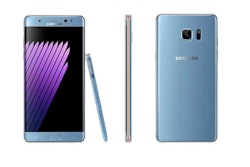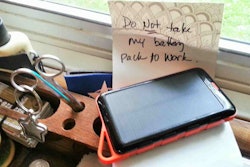I’m an expert at ruining expensive electronic devices. George calls me “Powder.” I will either destroy or suck the life out of a phone in a matter of minutes. Do. Not. Hand me your iPad, ever. Until we met Tom Buske, I had either destroyed or lost every power cord known to man. I really am the perfect person for testing something that’s supposed to be “Tough Tested.”
 Do. Not. Hand this person your iPad. Ever.
Do. Not. Hand this person your iPad. Ever.So Tom came along and changed my life with a battery pack (that I have still yet to kill or drop enough to make it quit working) and I think he may have felt a little bit sorry for me, because he’s aware of my affliction, and knows how terribly expensive my habit of killing electronic devices is. Because he’s a kind person, instead of flat out telling me I’m the reason I can’t have nice things, he wrote an informative piece about some of the ways we don’t charge our electronic devices properly and offered to let me share it here.
What I appreciate the most is that Tom sells this stuff for a living and will still tell you the best charger to use is the one the manufacturer provides with the device at point of sale. That’s great information, but it’s not always feasible to get a manufacturer’s replacement charger when you’re on the road, so the added tips on how to shop for your specific device replacement are helpful:
Being in “the business,” I tend to hear comments from friends, associates and customers like “Why does my phone charge so slowly?” or “My phone was plugged in all night and didn’t fully charge!” and “My phone gets really hot when I charge it.” Before I became a part of this industry, I used to ask some of the same questions. There is a reason, when purchasing a phone or other device, that it comes with a charger. It’s not just a nice idea or because the manufacturer wanted to just give you an extra “something” in the box. It’s because each device has its own power requirements and has its own unique relationship with the charger to ensure a safe and proper charge.
Our phones today are some of the most sophisticated electronic devices ever made — think about it — and we rely on them to store our most valuable data and memories. Chargers, on the other hand, are becoming cheaper and cheaper, without offering any over-current and over-voltage protection, or even the proper power specification to make sure those expensive electronic investments are protected.
Different devices have different charging circuitry and require a specific power “handshake” between charger and device to charge safely and optimally. Most iPads require 2.4 amps, the Galaxy Note series requires 2 amps, iPhones 1 amp, etc. All of these devices have a different power profile when it comes to charging. Generic chargers may work with any device, but they aren’t optimized to provide the most efficient or safe charge for every device.
Using the established voltage not only provides a faster charge, but some technologies recognize the voltage required and safely power a device to the manufacturer’s exact specification, just like that charger that came with your device. Most modern phones come with only a wall charger, so when charging on-the-go in your vehicle, we’ve left things to chance with generic chargers. Some aren’t even labeled with the correct amperage rating, further placing your device at risk. Using improper chargers for an electronic device can result in overheating, shortening of battery life and battery damage, or a complete shutdown of the device itself — not to mention increased charging times, and we all don’t like that! Devices and chargers are not created equal.
More tips for purchasing proper chargers, courtesy of Tough Tested’s Tom Buske
1) Check to ensure the device is optimized for different types of charges (i.e. tablets, iPhones, Android, etc.)
2) Use the original charger that came with your phone or device
3) Use voltage/surge protectors when charging devices, especially when in doubt of the quality of your charger
4) When you can’t use the original charger, look for products that have the technology to match the manufacturer’s intended power and specifications.










